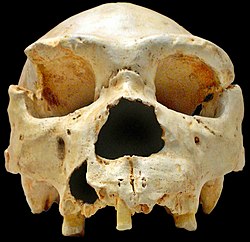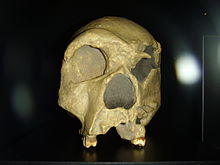Homo heidelbergensis: Difference between revisions
Aunt Entropy (talk | contribs) rv: unsourced |
Undid revision 309261241 by Aunt Entropy (talk) |
||
| Line 14: | Line 14: | ||
| binomial_authority = [[Otto Schoetensack|Schoetensack]], 1908 |
| binomial_authority = [[Otto Schoetensack|Schoetensack]], 1908 |
||
}} |
}} |
||
'''''Homo heidelbergensis''''' ("Heidelberg Man") is an [[extinct]] [[species]] of the [[genus]] ''[[Homo (genus)|Homo]]'' which |
'''''Homo heidelbergensis''''' ("Heidelberg Man") is an [[extinct]] [[species]] of the [[genus]] ''[[Homo (genus)|Homo]]'' which is the direct ancestor of both ''[[Homo neanderthalensis]]'' in [[Europe]] and Homo sapiens <ref>Article title |
||
Human Evolution in the Middle Pleistocene: The Role of Homo heidelbergensis |
|||
Author |
|||
Rightmire, G. P. |
|||
Journal title |
|||
EVOLUTIONARY ANTHROPOLOGY |
|||
Bibliographic details 1998, VOL 6; NUMBER 6, pages 218-227 [http://www.archeo.uw.edu.pl/zalaczniki/upload23.pdf pdf]</ref>The best evidence found for these hominin date between 600,000 and 400,000 years ago. ''H. heidelbergensis'' stone tool technology was considerably close to that of the [[Acheulean]] tools used by ''[[Homo erectus]]''. |
|||
==Morphology and interpretations== |
==Morphology and interpretations== |
||
Revision as of 03:11, 23 August 2009
| Homo heidelbergensis Temporal range: Pleistocene
| |
|---|---|

| |
| Scientific classification | |
| Domain: | |
| Kingdom: | |
| Phylum: | |
| Class: | |
| Order: | |
| Family: | |
| Genus: | |
| Species: | H. heidelbergensis
|
| Binomial name | |
| Homo heidelbergensis Schoetensack, 1908
| |
Homo heidelbergensis ("Heidelberg Man") is an extinct species of the genus Homo which is the direct ancestor of both Homo neanderthalensis in Europe and Homo sapiens [1]The best evidence found for these hominin date between 600,000 and 400,000 years ago. H. heidelbergensis stone tool technology was considerably close to that of the Acheulean tools used by Homo erectus.
Morphology and interpretations
Both H. antecessor and H. heidelbergensis are likely descended from the morphologically very similar Homo ergaster from Africa. But because H. heidelbergensis had a larger brain-case — with a typical cranial volume of 1100-1400 cm³ overlapping the 1350 cm³ average of modern humans — and had more advanced tools and behavior, it has been given a separate species classification. The species was tall, 1.8 m (6 ft) on average, and more muscular than modern humans.
Social behavior
In theory recent findings in Atapuerca also suggest that H. heidelbergensis may have been the first species of the Homo genus to bury their dead, but that is contested at this time. Some experts believe that H. heidelbergensis, like its descendant H. neanderthalensis acquired a primitive form of language. No forms of art or sophisticated artifacts other than stone tools have been uncovered, although red ochre, a mineral that can be used to create a red pigment which is useful as a paint, has been found at Terra Amata excavations in the south of France.
Language

The morphology of the outer and middle ear suggests they had an auditory sensitivity similar to modern humans and very different from chimpanzees. They were probably able to differentiate between many different sounds.[2] Dental wear analysis suggests they were as likely to be right handed as modern people.[3]
H. heidelbergensis was a close relative (most probably a migratory descendant) of H. ergaster. H. ergaster is thought to be the first hominin to speak, and therefore H. heidelbergensis probably could speak an early form of symbolic language as well.
Evidence of hunting
Cut marks found on wild deer, elephants, rhinoceroses and horses demonstrate that they were butchered. Some of the animals weighed as much as 700 kg (1,500 lb) or possibly larger. During this era, now-extinct wild animals such as mammoths, European lions and Irish elk roamed the European continent.
Moreover, a number of 400,000-year-old wooden projectile spears were found at Schöningen in northern Germany. These are thought to have been made by H. erectus or H. heidelbergensis. Generally, projectile weapons are more commonly associated with H. sapiens. The lack of projectile weaponry is an indication of different sustenance methods, rather than inferior technology or abilities. The situation is identical to that of native New Zealand Maori, modern H. sapiens, who also rarely threw objects, but used spears and clubs instead.[4]
Divergent Evolution
Most experts now agree that H. heidelbergensis is the direct ancestor of H. sapiens (with some indecision among such specimens as H. antecessor, now largely considered H. heidelbergensis) and H. neanderthalensis. Because of the radiation of H. heidelbergensis out of Africa and into Europe, the two populations were mostly isolated during the Wolstonian stage and Ipswichian stage, the last of the prolonged Quaternary glacial periods. Neanderthals diverged from H. heidelbergensis probably some 300,000 years ago in Europe, during the Wolstonian stage; H. sapiens probably diverged between 200,000 and 100,000 years ago in Africa. Such fossils as the Atapuerca skull and the Kabwe skull bear witness to the two branches of the H. heidelbergensis tree.
Homo neanderthalensis retained most of the features of H. heidelbergensis after its divergent evolution. Though shorter, Neanderthals were more robust, had large brow-ridges, a slightly protruding face and lack of prominent chin. They also had a larger brain than all other hominins. Homo sapiens, on the other hand, has the smallest brows of any known hominin, was tall and lanky, and had a flat face with a protruding chin. H. sapiens has a larger brain than H. heidelbergensis, and a smaller brain than H. neanderthalensis, on average. To date, H. sapiens is the only known hominin with an high forehead, flat face, and thin, flat brows.
Some believe that H. heidelbergensis is an extinct species, and some that it is a cladistic ancestor to other Homo forms sometimes improperly linked to distinct species in terms of populational genetics.
Some scenarios of survival include
- H heidelbergensis > H. neanderthalensis
- H. heidelbergensis > H. rhodesiensis > H. sapiens idaltu > H sapiens sapiens
Those supporting a multiregional origin of modern humans envision fertile reproduction between many evolutionary stages; Homo walking[5], or gene transfer between adjacent populations due to gene passage and spreading in successive generations.
Discovery

The first fossil discovery of this species was made on October 21, 1907, and came from Mauer where the workman Daniel Hartmann spotted a jaw in a sandpit. The jaw (Mauer 1) was in good condition except for the missing premolar teeth, which were eventually found near the jaw. The workman gave it to Professor Otto Schoetensack from the University of Heidelberg, who identified and named the fossil.
The next H. heidelbergensis remains were found in Steinheim an der Murr, Germany (the Steinheim Skull, 350mya); Arago, France (Arago 21); Petralona, Greece; and Ciampate del Diavolo, Italy.
Boxgrove Man
In 1994 British scientists unearthed a lower hominin tibia bone just a few kilometres away from the English Channel, along with hundreds of ancient hand axes, at the Boxgrove Quarry site. A partial leg bone is dated to between 478,000 and 524,000 years old. H. heidelbergensis was the early proto-human species that occupied both France and Great Britain at that time; both locales were connected by a landmass during that epoch. Prior to Gran Dolina, Boxgrove offered the earliest hominid occupants in Europe.
The tibia had been gnawed by a large carnivore, suggesting that he had been killed by a lion or wolf or that his unburied corpse had been scavenged after death [6].
Sima de los Huesos
Beginning in 1997, a Spanish team has located more than 5,500 human bones dated to an age of at least 350,000 years in the Sima de los Huesos site in the Sierra de Atapuerca in northern Spain. The pit contains fossils of perhaps 28 individuals together with remains of Ursus deningeri and other carnivores and a biface called Excalibur. It is hypothesized that this Acheulean axe made of red quartzite was some kind of ritual offering for a funeral. Ninety percent of the known H. heidelbergensis remains have been obtained from this site. The fossil pit bones include:
- A complete cranium (Skull 5), nicknamed Miguelón, and fragments of other craniums, such as Skull 4, nicknamed Agamenón and skull 6, nicknamed Rui (from El Cid, a local hero).
- A complete pelvis (Pelvis 1), nicknamed Elvis, in remembrance of Elvis Presley.
- Mandibles, teeth, and many postcranial bones (femurs, hand and foot bones, vertebrae, ribs, etc.)
Indeed, nearby sites contain the only known and controversial Homo antecessor fossils.
See also
- List of fossil sites (with link directory)
- List of hominina (hominid) fossils (with images)
- Saldanha man
- Altamura man
References
- ^ Article title Human Evolution in the Middle Pleistocene: The Role of Homo heidelbergensis Author Rightmire, G. P. Journal title EVOLUTIONARY ANTHROPOLOGY Bibliographic details 1998, VOL 6; NUMBER 6, pages 218-227 pdf
- ^ Martinez, I., L. Rosa, J.-L. Arsuaga, P. Jarabo, R. Quam, C. Lorenzo, A. Gracia, J.-M. Carretero, J.M. Bermúdez de Castro, E. Carbonell (2004). "Auditory capacities in Middle Pleistocene humans from the Sierra de Atapuerca in Spain". PNAS. 101 (27): 9976–9981. doi:10.1073/pnas.0403595101. PMID 15213327.
{{cite journal}}: Unknown parameter|month=ignored (help)CS1 maint: multiple names: authors list (link) - ^ Lozano M, Mosquera M, de Castro J, Arsuaga J, Carbonell E. (2009). Right handedness of Homo heidelbergensis from Sima de los Huesos (Atapuerca, Spain) 500,000 years ago. Evolution and Human Behavior 30:369–376. doi:10.1016/j.evolhumbehav.2009.03.001
- ^ Schwimmer, E.G. "Warfare of the Maori." Te Ao Hou: The New World, #36, Sept 1961, pp. 51-53. [1]
- ^ Was Homo heidelbergensis in South Asia? A test using the Narmada fossil from central India Book Series Vertebrate Paleobiology and Paleoanthropology Series Book The Evolution and History of Human Populations in South Asia Publisher Springer Netherlands DOI 10.1007/1-4020-5562-5 Copyright 2007 ISBN 978-1-4020-5561-4 (Print) 978-1-4020-5562-1 (Online) Part Part I DOI 10.1007/1-4020-5562-5_7 Pages 137-170 Subject Collection Humanities, Social Sciences and Law SpringerLink Date Tuesday, May 22, 2007[2]
- ^ A History of Britain, Richard Dargie (2007), p. 8-9
- Sauer, A. (1985). Erläuterungen zur Geol. Karte 1 : 25 000 Baden-Württ. Stuttgart.
{{cite book}}: CS1 maint: location missing publisher (link) - Schoetensack, O. (1908). Der Unterkiefer des Homo heidelbergensis aus den Sanden von Mauer bei Heidelberg. Leipzig: Wilhelm Engelmann.
- Weinert, H. (1937). "Dem Unterkiefer von Mauer zur 30-jährigen Wiederkehr seiner Entdeckung". Z. f. Morphol. u. Anthropol. XXXVII (1): pp. 102–113.
{{cite journal}}:|pages=has extra text (help) - Rice, Stanley (2006). Encyclopedia of Evolution. Facts on File, Inc.
